Mo Yu
FaceID-6M: A Large-Scale, Open-Source FaceID Customization Dataset
Mar 11, 2025Abstract:Due to the data-driven nature of current face identity (FaceID) customization methods, all state-of-the-art models rely on large-scale datasets containing millions of high-quality text-image pairs for training. However, none of these datasets are publicly available, which restricts transparency and hinders further advancements in the field. To address this issue, in this paper, we collect and release FaceID-6M, the first large-scale, open-source FaceID dataset containing 6 million high-quality text-image pairs. Filtered from LAION-5B \cite{schuhmann2022laion}, FaceID-6M undergoes a rigorous image and text filtering steps to ensure dataset quality, including resolution filtering to maintain high-quality images and faces, face filtering to remove images that lack human faces, and keyword-based strategy to retain descriptions containing human-related terms (e.g., nationality, professions and names). Through these cleaning processes, FaceID-6M provides a high-quality dataset optimized for training powerful FaceID customization models, facilitating advancements in the field by offering an open resource for research and development. We conduct extensive experiments to show the effectiveness of our FaceID-6M, demonstrating that models trained on our FaceID-6M dataset achieve performance that is comparable to, and slightly better than currently available industrial models. Additionally, to support and advance research in the FaceID customization community, we make our code, datasets, and models fully publicly available. Our codes, models, and datasets are available at: https://github.com/ShuheSH/FaceID-6M.
DBudgetKV: Dynamic Budget in KV Cache Compression for Ensuring Optimal Performance
Feb 24, 2025Abstract:To alleviate memory burden during inference of large language models (LLMs), numerous studies have focused on compressing the KV cache by exploring aspects such as attention sparsity. However, these techniques often require a pre-defined cache budget; as the optimal budget varies with different input lengths and task types, it limits their practical deployment accepting open-domain instructions. To address this limitation, we propose a new KV cache compression objective: to always ensure the full-cache performance regardless of specific inputs, while maximizing KV cache pruning as much as possible. To achieve this goal, we introduce a novel KV cache compression method dubbed DBudgetKV, which features an attention-based metric to signal when the remaining KV cache is unlikely to match the full-cache performance, then halting the pruning process. Empirical evaluation spanning diverse context lengths, task types, and model sizes suggests that our method achieves lossless KV pruning effectively and robustly, exceeding 25% compression ratio on average. Furthermore, our method is easy to integrate within LLM inference, not only optimizing memory space, but also showing reduced inference time compared to existing methods.
The Stochastic Parrot on LLM's Shoulder: A Summative Assessment of Physical Concept Understanding
Feb 13, 2025Abstract:In a systematic way, we investigate a widely asked question: Do LLMs really understand what they say?, which relates to the more familiar term Stochastic Parrot. To this end, we propose a summative assessment over a carefully designed physical concept understanding task, PhysiCo. Our task alleviates the memorization issue via the usage of grid-format inputs that abstractly describe physical phenomena. The grids represents varying levels of understanding, from the core phenomenon, application examples to analogies to other abstract patterns in the grid world. A comprehensive study on our task demonstrates: (1) state-of-the-art LLMs, including GPT-4o, o1 and Gemini 2.0 flash thinking, lag behind humans by ~40%; (2) the stochastic parrot phenomenon is present in LLMs, as they fail on our grid task but can describe and recognize the same concepts well in natural language; (3) our task challenges the LLMs due to intrinsic difficulties rather than the unfamiliar grid format, as in-context learning and fine-tuning on same formatted data added little to their performance.
Understanding LLMs' Fluid Intelligence Deficiency: An Analysis of the ARC Task
Feb 11, 2025Abstract:While LLMs have exhibited strong performance on various NLP tasks, it is noteworthy that most of these tasks rely on utilizing the vast amount of knowledge encoded in LLMs' parameters, rather than solving new problems without prior knowledge. In cognitive research, the latter ability is referred to as fluid intelligence, which is considered to be critical for assessing human intelligence. Recent research on fluid intelligence assessments has highlighted significant deficiencies in LLMs' abilities. In this paper, we analyze the challenges LLMs face in demonstrating fluid intelligence through controlled experiments, using the most representative ARC task as an example. Our study revealed three major limitations in existing LLMs: limited ability for skill composition, unfamiliarity with abstract input formats, and the intrinsic deficiency of left-to-right decoding. Our data and code can be found in https://wujunjie1998.github.io/araoc-benchmark.github.io/.
The Essence of Contextual Understanding in Theory of Mind: A Study on Question Answering with Story Characters
Jan 03, 2025



Abstract:Theory-of-Mind (ToM) is a fundamental psychological capability that allows humans to understand and interpret the mental states of others. Humans infer others' thoughts by integrating causal cues and indirect clues from broad contextual information, often derived from past interactions. In other words, human ToM heavily relies on the understanding about the backgrounds and life stories of others. Unfortunately, this aspect is largely overlooked in existing benchmarks for evaluating machines' ToM capabilities, due to their usage of short narratives without global backgrounds. In this paper, we verify the importance of understanding long personal backgrounds in ToM and assess the performance of LLMs in such realistic evaluation scenarios. To achieve this, we introduce a novel benchmark, CharToM-QA, comprising 1,035 ToM questions based on characters from classic novels. Our human study reveals a significant disparity in performance: the same group of educated participants performs dramatically better when they have read the novels compared to when they have not. In parallel, our experiments on state-of-the-art LLMs, including the very recent o1 model, show that LLMs still perform notably worse than humans, despite that they have seen these stories during pre-training. This highlights the limitations of current LLMs in capturing the nuanced contextual information required for ToM reasoning.
Large Language Models Can Self-Improve in Long-context Reasoning
Nov 12, 2024

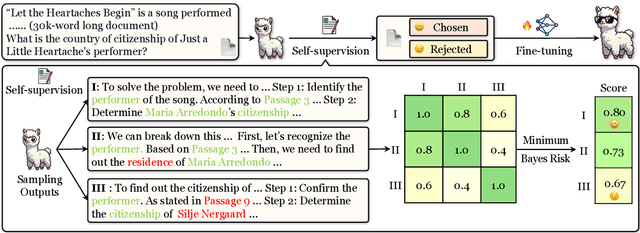
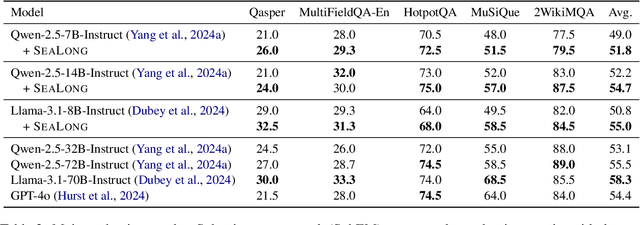
Abstract:Large language models (LLMs) have achieved substantial progress in processing long contexts but still struggle with long-context reasoning. Existing approaches typically involve fine-tuning LLMs with synthetic data, which depends on annotations from human experts or advanced models like GPT-4, thus restricting further advancements. To address this issue, we investigate the potential for LLMs to self-improve in long-context reasoning and propose \ours, an approach specifically designed for this purpose. This approach is straightforward: we sample multiple outputs for each question, score them with Minimum Bayes Risk, and then apply supervised fine-tuning or preference optimization based on these outputs. Extensive experiments on several leading LLMs demonstrate the effectiveness of \ours, with an absolute improvement of $4.2$ points for Llama-3.1-8B-Instruct. Furthermore, \ours achieves superior performance compared to prior approaches that depend on data produced by human experts or advanced models. We anticipate that this work will open new avenues for self-improvement techniques in long-context scenarios, which are essential for the continual advancement of LLMs.
On the token distance modeling ability of higher RoPE attention dimension
Oct 11, 2024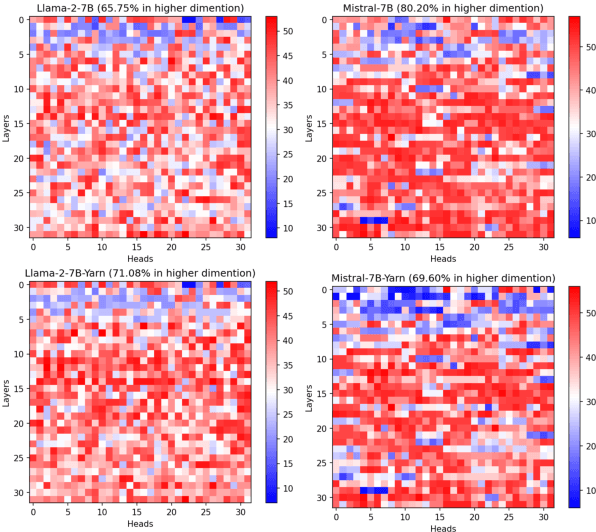
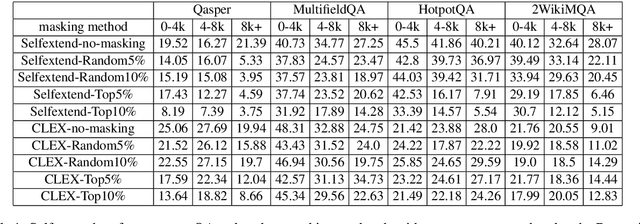
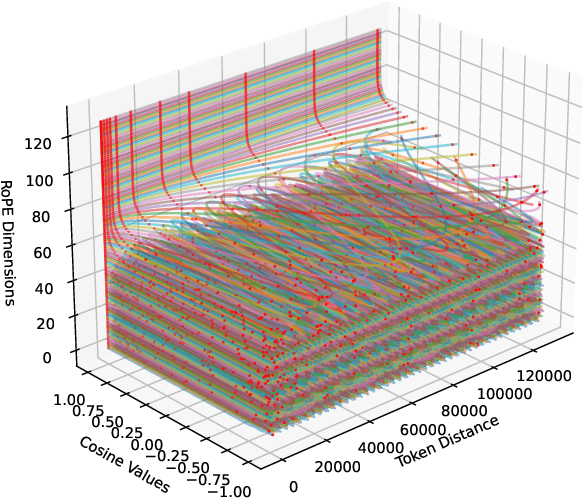

Abstract:Length extrapolation algorithms based on Rotary position embedding (RoPE) have shown promising results in extending the context length of language models. However, understanding how position embedding can capture longer-range contextual information remains elusive. Based on the intuition that different dimensions correspond to different frequency of changes in RoPE encoding, we conducted a dimension-level analysis to investigate the correlation between a hidden dimension of an attention head and its contribution to capturing long-distance dependencies. Using our correlation metric, we identified a particular type of attention heads, which we named Positional Heads, from various length-extrapolated models. These heads exhibit a strong focus on long-range information interaction and play a pivotal role in long input processing, as evidence by our ablation. We further demonstrate the correlation between the efficiency of length extrapolation and the extension of the high-dimensional attention allocation of these heads. The identification of Positional Heads provides insights for future research in long-text comprehension.
A Survey on the Honesty of Large Language Models
Sep 27, 2024



Abstract:Honesty is a fundamental principle for aligning large language models (LLMs) with human values, requiring these models to recognize what they know and don't know and be able to faithfully express their knowledge. Despite promising, current LLMs still exhibit significant dishonest behaviors, such as confidently presenting wrong answers or failing to express what they know. In addition, research on the honesty of LLMs also faces challenges, including varying definitions of honesty, difficulties in distinguishing between known and unknown knowledge, and a lack of comprehensive understanding of related research. To address these issues, we provide a survey on the honesty of LLMs, covering its clarification, evaluation approaches, and strategies for improvement. Moreover, we offer insights for future research, aiming to inspire further exploration in this important area.
Are LLM-based Recommenders Already the Best? Simple Scaled Cross-entropy Unleashes the Potential of Traditional Sequential Recommenders
Aug 26, 2024Abstract:Large language models (LLMs) have been garnering increasing attention in the recommendation community. Some studies have observed that LLMs, when fine-tuned by the cross-entropy (CE) loss with a full softmax, could achieve `state-of-the-art' performance in sequential recommendation. However, most of the baselines used for comparison are trained using a pointwise/pairwise loss function. This inconsistent experimental setting leads to the underestimation of traditional methods and further fosters over-confidence in the ranking capability of LLMs. In this study, we provide theoretical justification for the superiority of the cross-entropy loss by demonstrating its two desirable properties: tightness and coverage. Furthermore, this study sheds light on additional novel insights: 1) Taking into account only the recommendation performance, CE is not yet optimal as it is not a quite tight bound in terms of some ranking metrics. 2) In scenarios that full softmax cannot be performed, an effective alternative is to scale up the sampled normalizing term. These findings then help unleash the potential of traditional recommendation models, allowing them to surpass LLM-based counterparts. Given the substantial computational burden, existing LLM-based methods are not as effective as claimed for sequential recommendation. We hope that these theoretical understandings in conjunction with the empirical results will facilitate an objective evaluation of LLM-based recommendation in the future.
An Energy-based Model for Word-level AutoCompletion in Computer-aided Translation
Jul 29, 2024Abstract:Word-level AutoCompletion(WLAC) is a rewarding yet challenging task in Computer-aided Translation. Existing work addresses this task through a classification model based on a neural network that maps the hidden vector of the input context into its corresponding label (i.e., the candidate target word is treated as a label). Since the context hidden vector itself does not take the label into account and it is projected to the label through a linear classifier, the model can not sufficiently leverage valuable information from the source sentence as verified in our experiments, which eventually hinders its overall performance. To alleviate this issue, this work proposes an energy-based model for WLAC, which enables the context hidden vector to capture crucial information from the source sentence. Unfortunately, training and inference suffer from efficiency and effectiveness challenges, thereby we employ three simple yet effective strategies to put our model into practice. Experiments on four standard benchmarks demonstrate that our reranking-based approach achieves substantial improvements (about 6.07%) over the previous state-of-the-art model. Further analyses show that each strategy of our approach contributes to the final performance.
 Add to Chrome
Add to Chrome Add to Firefox
Add to Firefox Add to Edge
Add to Edge